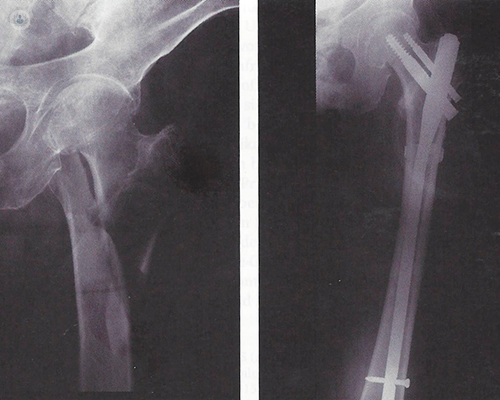

What is a femur fracture?
The femur, also known as the thigh bone, is the strongest and longest bone in the body, and therefore to fracture this bone it can take a lot of force. Hence, car accidents are often a major cause of femur fractures. A femur fracture will very often require surgical treatment.

Symptoms of a femur fracture:
A femur fracture would cause severe pain and you would be unable to put weight on the affected leg.
The pain experienced would depend on the type of fracture and the following considerations:
- The pattern of the fracture and how the break occurs through the bone
- The location of the fracture
- Whether or not the skin and muscle is intact or if it was torn by the injury
Medical tests to diagnose a femur fracture:
When a patient is seen who has a suspected femur fracture, a doctor will want to know how the injury occurred. Following a physical examination that looks for any deformity, breaks, bruising and bone fragments pushing on the skin, imaging tests will be used to provide more information and detail about the fracture.
An X-ray scan is the most common way to assess a fracture, and will show where the bone is broken within the femur and what sort of fracture it is. A CT scan may also be used if an X-ray isn’t providing enough detail.
What are the causes of a femur fracture?
The most common cause of femur fractures are high-impact car accidents or motorbike collisions. Other common causes include:
- Falling from a height
- Being hit by a car as a pedestrian
- Gunshot wounds
- A fall from standing, in older people with weakened bones
Treatments for a femur fracture:
It is unusual for a femur fracture to heal without surgical treatment and most femur fractures will be operated on within 24-48 hours of diagnosis. Before surgery the leg will be supported by a splint to keep the bones aligned and to maintain the length of the leg as much as possible.
The following are the main surgical treatments used to treat femur fractures:
- External fixation – metal pins are anchored into the femur bone above and below the fracture. These pins are attached to a bar outside the skin. This bar and the pins will hold the bones in position whilst they heal. This is often a temporary treatment used until a patient can handle further surgery.
- Plates and screws – the bones and fragments are repositioned and then held in place with special screws and plates which are attached to the outer surface of the femur bone.
- Intramedullary nailing – this procedure is used most often to treat femur fractures and involves a metal rod being inserted into the canal of the femur bone to keep the fracture in position and aligned. The rod is inserted at the hip or the knee and screws are used to secure the rod at the top and bottom of the femur.
Recovery from a femur fracture:
Most femur fractures take up to 6 months to fully heal. During that period there will be pain, with some short-term pain relief given after surgery. Physical therapy during the recovery period will help regain strength and mobility.
Which type of specialist treats a femur fracture?
An orthopaedic surgeon would treat femur fractures.
